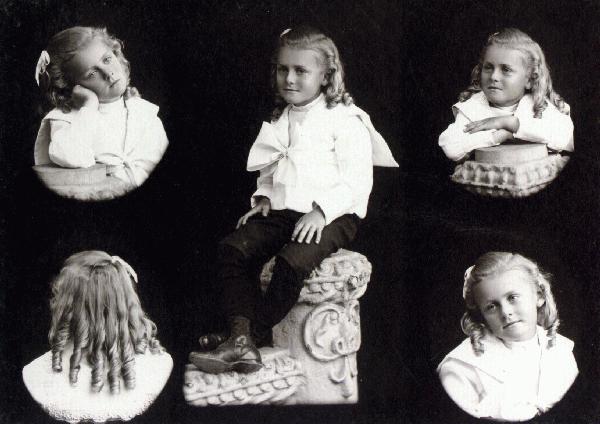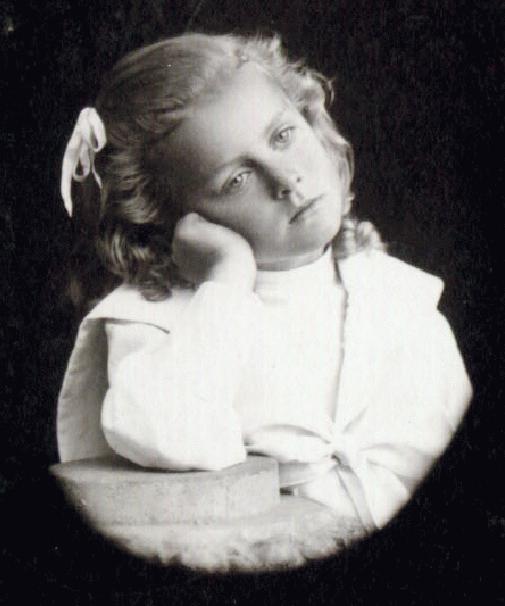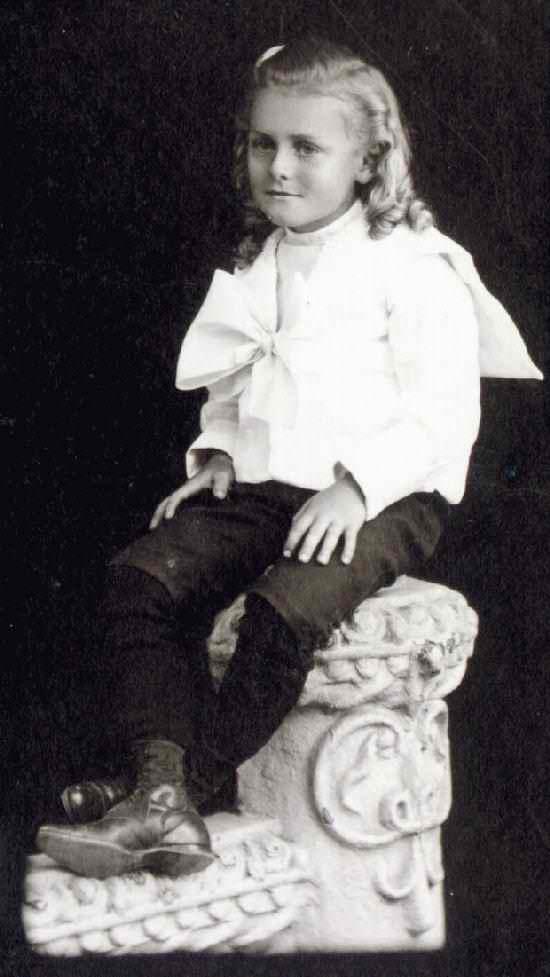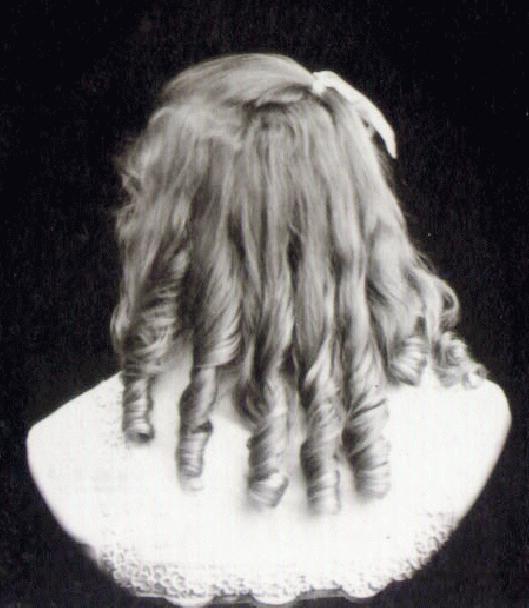

Figure 1.--This California boy was photographed from several different angles, probably during the 1890s. His mother may have had this done, because he was about to have his curls cut. Unlike many boys in these old portraits, he seems rather at ease in front of the camera and does not show any particular objection to either his ringlets or hair bow. Image courtesy of the RG collection.
|
Boys' Ringlet Curls: Unidentified California Boy
This California boy has elaborate ringlet curls which he wears with a rather plain, but elegany middy blouse and kneepants. We do not know his name, but he looks to be about 5-6 years old. All we know about him is that he lived in California. His ringlets, decorated with a hair bow, were clearly the focus of the portarits. He was photographed from several different angles, probably during the 1890s. HBC suspects that mother may have had this done, because he was about to have his curls cut. Unlike many boys in these old portraits, he seems rather at ease in front of the camera and does not show any particular objection to either his ringlets or even the hair bow.
Chronology
This portrait is undated. HBC believes, however, that it was probably taken in the 1890s or perhaps the early 190s. We believe, however, the 1890s is the most likely. This is primarily because we have not noted the white middy blouse he is wearing to have been common in the 1880s. Also the posing seems a bit duifferent to that we normally see in the 1880s. The photographer's effort to obtain more relaxed fluid expressions also suggests the 1890s rather than the 1880s. The fact that the kneepants do not have creases also helps date the image to the 1890s rather than the 1900s. The large size of the sailor bow suggests that it was not taken in the 1900s, at least much beyond about 1905.
Location
We are positive that this is an American boy. The only provinance in fact that we have for this portrait is the fact that it was taken at the Young studio in Riverside California.

Figure 2.--The boy here seems to be at ease in front of the camera. The photographer has suceeded in getting a relaxed, contemplative pose, a rarity in these 19tyh century portraits.
|
Portrait
The boy's ringlets, decorated with a hair bow, were clerly the focus of the portraits. He was photographed from several different angles, probably during the 1890s. HBC suspects that mother may have had this done, because he was about to have his curls cut. Unlike many boys in these old portraits, he seems rather at ease in front of the camera and does not show any particular objection to either his ringlets or even the hair bow. The photographer has suceeded in getting a relaxed, contemplative pose, a rarity in these 19th century portraits. We note that authors often comment on how unhappy the boys look in these old photographs, ascribing this to their dislike of their often elablorate hair styles or clothes. HBC believes that this often is not the case. More likely the problem was slow film and low exposure times. Thus photographers often did not encourage smiles, but rather more static expressions. This is one reason we believe this is a 1890s portrait because film speeds were much improved by that time. Because the boy's mother clearly wanted the focus of the portait to be on her son's ringlets, there are no props intriduced for the boy, except pillars for him to stand or lean on.
Mother
Mother clearly adored her little boy. You get the impression that he was perhaps the only child. Mother was clearly not satisfied with just one simple photograph. Rather she wanted her son's glorious ringle curls photographed from several different angles. The results would undiubtedly be lovinglu placed in the family albumn where family and guests would be allowed to admire the results. We suspect that when he was a little older that he was not especially enamored with this.
Boy
We do not know his name, but he looks to be about 5-6 years old. He clearly had a most devoted mother willing to spend her time and energy maintaining such an elaboratre hair style. His clothes do not suggest he came from a particularly wealthy family, but this may be deceptive, because while plain, they are rather elegant. The ringlets suggest, however, some degree of affluence. His mother or servants clearly had a good deal of time on their hands. The fact that mother had several different exposures made also suggests that the family was well off.

Figure 3.--This California boy has elaborate ringlet curls which he wears with a rather plain, but elegant middy blouse and kneepants. While this boy's ringlet curls are the principal focus of the portraits, there are some interesting aspects to his clothing as well.
|
Clothes
This California boy has elaborate ringlet curls which he wears with a rather plain, but elegant middy blouse and kneepants. While this boy's ringlet curls are the principal focus of the portraits, there are some interesting aspects to his clothing as well.
Middy blouse
The boy wears a plain white middy blouse. The middy blouse is all white without any detailing. The blouse itself is a very plain, standard midddy blouse with a wide back flap. The only notable feature is the lack of detailing. One is struck that the boy's mother would have selected such a plain middy blouse for such an elaborate hair style. But of course the plainness of the blouse only draws one's attention more to the boys' ringlet curls. The blouse itself seems to be very heavily statched. Notice how the cuffs and back flap stand out. The middy blouse has a square back flap. For some reason it looks rounded in thr back view (fihure 4).
Dickie
He wears his middy blouse with a matching white dicky also without any detailing. It is worn high up on his neck.
Bow
Although almost lost because of the color, he also wears a huge elegant, natily tied white bow. Large bows were quite common in the 1880s and 90s, but this seems larger than most. It is rather unusual for such large bows to be used on middy blouses.
Lace mantel
Mothers being mothers, however, this boys mother simply could not restrain herself from embelishing her son's middy blouse. The large bow was judged just not to be adequate decoration. She added an elaborate lace mantel to the back flap of his middy blouse (figure 4). The lace is only visible in the back view seen below. HBC has not noted this particular style of decoration. Usually mothers wanted lace to be seen at the front also. We are not even sure how it was attached. It does not show off well even from the back being attached to the all white back flap. But apparently it made mother happy knowing her little treasure had atleast some lace decorating his outfit.
Kneepants
The boy wears a pair of dark kneepants without any pattern. The kneepants do not have a crease. Given how attentive this boy's mother is and how crisply starched the middu blouse is, this suggests that creases had not yet become fashionable yet, another fact in dating the portrait to the 1890s. The black and white photography offers no clues as to the color of the kneepants. They clearly were not balck, but I am not sure about the color.
Hosiery
The boy wears black long stockings as was common with kneepants in America at the time. European boys commonly wore socks with kneepants, especially during the summer. Long stockings were much more common in America. They look to be rather heavy stockings.
Footwear
He wears high top shoes. presumably button shoes, but it is hard to tell from the photograph.

Figure 4.--We note eight ringlets in this back view, but there may have been more. Note the lace mantel that has been added to the back flap of the middy blouse. Note how the hair bow is tied to one of the ringlets. I'm not sure what the photographer has done here. The boy's middy blouse had a square back flap, but here it is rounded.
|
Hair Style
The boy's hair is done without any front bangs. Rather the hair is swept back with a left part. The part is continued around the back of the head. There appear to be eight ringlets, although it is difficult to be positive about that. I suspect that there may be more on his right side that are not visible in the back view here. Some boys had their hair done with more ringlets. These are ringlets of medium diameter, but they are very disctetely sine as was common for most boys with ringlet curls in America. The ringlets are of normal length for this style, extending to the boy's shoulders and down his back. Mother has carefully arranged the ringlets in most of the poses so that some show to best effect on his shoulders. We assume this was mother's doing. The photographer was almost surely a man. HBC has heard of very few women photographers in the 19th century. It could have been thecphotographer who did this himself, perhaps learningh many such shoots just what mothers wanted.
Hair Bow
As is normally the case with boys' hair bows, the ribbon is rather slender. This one looks to be white. It is tied to the side of the head, which was also common for boys. The back view here shows just how the hair bow ribbon was tied to the top of one of the ringlets. HBC still has limited information about the conventions for hair bows in America. We suspect thaey may have been worn for special occassions or for portraits like this rather than for every day. We have, however, very little written information from contemporary sources providing information on this.
Christopher Wagner

[Return to the Main ringlet curl American page]
[Return to the Main ordinary people biography page]
[Teturn to the Main ringlet curl page]
[Return to the Main curl page]
[Bangs]
[Long hair]
[Hair bows]
[Caps]
[Collar bows]
Navigate the Boys' Historical Clothing Web Site:
[Introduction]
[Activities]
[Biographies]
[Chronology]
[Clothing styles]
[Countries]
[Bibliographies]
[Contributions]
[FAQs]
[Glossaries]
[Satellite sites]
[Tools]
[Boys' Clothing Home]
Created: May 28, 2002
Last edited: May 28, 2002






